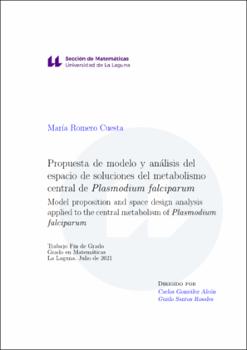Propuesta de modelo y análisis del espacio de soluciones del metabolismo central de Plasmodium falciparum
Autor
Romero Cuesta, MaríaFecha
2021Resumen
La malaria es una enfermedad mortal que afecta a gran parte de la
poblaci´on en pa´ıses subdesarrollados. Esta enfermedad est´a causada
por varias especies de protozoos del g´enero Plasmodium, siendo Plasmodium falciparum el m´as frecuente y letal de ellos en humanos. El
conocimiento incompleto de las rutas metab´olicas de P. falciparum
se ha identificado como el impedimento principal para el desarrollo
de estrategias efectivas contra su supervivencia.
La modelizaci´on matem´atica y el enfoque computacional pueden resultar de gran utilidad para analizar el comportamiento y la tolerancia del sistema bajo diferentes circunstancias con el fin de obtener
una mayor comprensi´on de la biolog´ıa del par´asito. En este trabajo se propone un modelo matem´atico del metabolismo central de P.
falciparum para la fase asexual utilizando el formalismo GMA. El estudio se centra en los procesos que transcurren desde que el par´asito
invade un gl´obulo rojo hasta que degrada toda la hemoglobina disponible para aumentar su biomasa y disponer de energ´ıa con el fin de
dividirse y comenzar otro ciclo de invasi´on.
La simulaci´on computacional del modelo y el an´alisis temporal de
las soluciones han permitido establecer relaciones entre la energ´ıa
disponible en el par´asito para dividirse y colonizar nuevos eritrocitos
y la velocidad de la reacci´on de conversi´on de piruvato a acetil-CoA y
la velocidad de incorporaci´on de piruvato a biomasa. Estos resultados
indican que la mol´ecula de piruvato juega un papel decisivo en el
metabolismo de P. falciparum para la obtenci´on de energ´ıa. Malaria is a dreadful disease that affects most of underdeveloped
countries’ population. This disease is caused by many species of protozoa from the Plasmodium gender being Plasmodium falciparum the
most frequent and deathly of all in humans. The incomplete knowledge of the metabolic pathways of P. falciparum has been identified as
a major issue for the achivement of effective strategies to overcome
its survival.
Mathematical modelling and computational methods might be of most
use to analise the behaviour and tolerance of the system under different circumstances so as to obtain a better understanding of the
biology of the parasite. In the present work, a mathematical model of
the central metabolism of P. falciparum is proposed for its asexual
cycle using the GMA formalism. This study is focused on the processes that occur from invasion of a red blood cell until dregadation of
all the available hemoglobin to increase its biomass and have energy
in order to multiply and start a new invasion cycle.
The computational simulation of the model and the space design
analysis enabled us to establish relations between the available energy
in the parasite to multiply and colonize new red blood cells and the
reaction rates of the conversion from pyruvate to acetyl-CoA and of
the incorporation of pyruvate to its biomass. These results suggest
that the pyruvate molecule plays a key role in the metabolism of P.
falciparum for energy supply.





